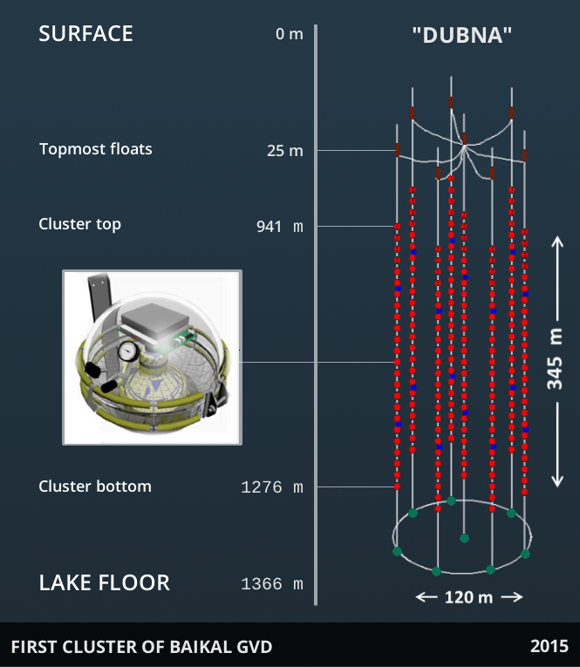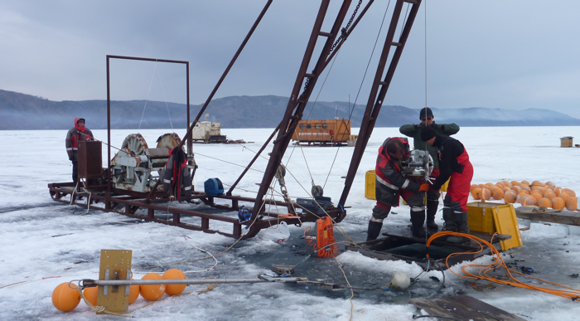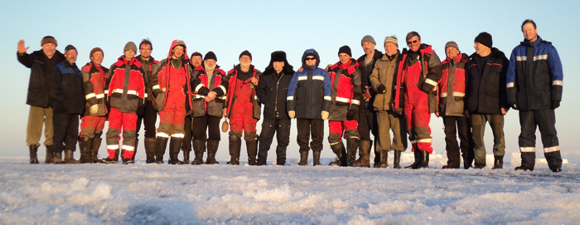The first cluster of Baikal-GVD, a deep underwater neutrino telescope on the cubic kilometer scale, has started operation in Lake Baikal
19.05.2015Joint Institute for Nuclear Research
Press release
The first cluster of Baikal-GVD, a deep underwater neutrino telescope on the cubic kilometer scale, has started operation in Lake Baikal
In early April 2015, scientists of the “Baikal” collaboration deployed and put into operation the first substructure of a unique experimental complex – the deep underwater neutrino telescope Baikal-GVD. This sub-detector was named “DUBNA”. It encloses several Megatons of the clear waters of Lake Baikal. Members of the Baikal collaboration include the Institute for Nuclear Research of the Russian Academy of Sciences, the Joint Institute for Nuclear Research (Dubna), and other Russian scientific organizations.
Baikal-GVD (Gigaton Volume Detector) will be at the cubic-kilometer scale. It will allow studying in detail the natural neutrino flux at high energy. Having passed through Earth, a neutrino can, with some probability, interact in the water of Lake Baikal and generate a cascade of charged particles. Cherenkov radiation from charged particles propagates through the water and is detected with “optical modules”, the basic elements of GVD. The DUBNA cluster comprises 192 optical modules arranged at depths down to 1,300 m. It is now one of the three largest neutrino detectors in the world. Over its next stages of evolution, the telescope will be stepwise extended by deploying new clusters. By 2020, it will consist of 10-12 clusters with a total volume of about 0.5 cubic kilometers. This will be comparable to the sensitive volume of the world leader – the neutrino telescope IceCube.

The neutrino detection in Lake Baikal will allow one to better understand the high-energy processes that occur in far distant astrophysical sources, to determine the origin of cosmic particles of the highest energies ever registered, to discover new properties of elementary particles and to learn a great deal of new information about the structure and evolution of the Universe as a whole.
V. Rubakov – Academician and head of the Nuclear Physics Section of the Russian Academy of Sciences:
“In the ensemble of all elementary particles, for today the neutrino occupies the position of one of its lightest members and for recent decades has firmly secured the reputation of an “extreme intriguer”. The unique character of this particle as a messenger carrying information about processes that take place in the Universe is determined by its weak interaction with matter.
The natural neutrino flux carries the richest, and in many aspects unique, information about our world. The studies of this flux in various energy ranges can give us clues to understanding of early stages of the cosmic evolution, processes of chemical elements’ formation, the evolution mechanism of massive stars and of Supernova explosions, can shed light on the problem of dark (invisible) matter and on the composition and inner structure of the Sun today and in the distant Past, and even advance our understanding of the inner structure of one of the objects that are most difficult to be studied – the Planet Earth.”
V. Matveev – Academician and director of the Joint Institute for Nuclear Research (Dubna):
“The idea to register elementary particles with large-scale Cherenkov detectors in natural transparent media was expressed for the first time in the early 1960s by the eminent Soviet scientist M. Markov. Following a suggestion of A. Chudakov, Lake Baikal was considered as a testing range and a site for future large-scale neutrino telescopes. The choice of Lake Baikal was determined by the high transparency of deep fresh water, the depth of the lake, and the ice cover that allows installing deep water equipment during two winter months. October 1, 1980 can be regarded the start of the Baikal neutrino experiment. At this date, the laboratory of neutrino astrophysics of high energy, headed by G. Domogatsky, was established at the Institute for Nuclear Research AS USSR (now INR RAS). Later it became the core of the Baikal collaboration that included in different periods the Joint Institute for Nuclear Research (Dubna), Irkutsk State University, Moscow Lomonosov State University, the research centre DESY-Zeuthen (Germany), the Nizhni Novgorod State Technical University, the St. Petersburg State Marine Technical University and other scientific research organizations of Russia, Hungary, Germany, the Czech Republic and Slovakia. Today the participation of the Cracow Institute for Nuclear Physics (Poland) is under discussion.

The worldwide first deep underwater neutrino telescope NT200 was constructed in the years 1993-1998. It comprised 192 photodetectors grouped into eight vertical strings placed at the depth of 1100-1200 m and enclosing about 100 000 cubic meters of fresh water. The experimental data of 1994 already showed neutrino events – the first in the world-wide race of deep underwater and deep-ice experiments. A wide programme of scientific research was implemented and important results were obtained in searches for local neutrino sources and a diffuse cosmic neutrino flux. Limits were derived on the flux of magnetic monopoles and of muons from dark matter annihilation in the centre of the Earth and the Sun.
The idea of deep underwater detection in its ice modification, when instead of a water reservoir the photodetectors are placed into transparent Antarctic ice, led to the construction of the neutrino telescope IceCube at the South Pole, enclosing 1 cubic kilometer of ice. Leading participants are the USA, Germany, Sweden and Belgium. IceCube has detected in 2010-2013 for the first time ‘astrophysical’ (or ‘cosmic’) neutrinos of high energy, i.e. neutrinos generated beyond the solar system. The registration of these neutrinos marked the birth of high-energy neutrino astronomy and called for developing neutrino telescopes of similar capacity in the Northern hemisphere, with the aim to conduct studies of high energy neutrino sources over the whole celestial sphere. JINR gained a lot of experience from many years participating in the Baikal neutrino project, so a decision was taken to regard activities towards BAIKAL-GVD as one of JINR’s scientific priorities.”
G. Domogatsky – RAS Corresponding Member and coordinator of the Baikal neutrino project:
“The successful operation of the NT200 neutrino telescope over a decade and the results from the recorded data have shown the effectiveness of the deep underwater neutrino detection method in the fresh water of Lake Baikal. The next stage is the work out of the project for a telescope of a new generation - BAIKAL-GVD – with a monitored volume of about 1 cubic kilometer water. During 2006-201 all basic elements and the whole system of Baikal-GVD were designed, manufactured and tested. The telescope will have a modular structure that is formed from functionally independent sub-structures – clusters of vertical strings of optical modules. The module structure of the telescope will allow data acquisition at early stages of the facility construction and allows an essentially unlimited increase of its volume. The choice of the telescope structure will also allow adjustments of its configuration due to various changes of scientific priorities at different periods. In 2011 we started the final stages of complex in-situ tests. These tests were completed in 2015 with the deployment of the “Dubna” cluster”. The cluster contains 192 photodetectors positioned on 8 vertical strings, each 345 m long, and is one of two powerful neutrino high-energy detectors in the Northern hemisphere. The next stage of the Baikal-GVD project is the stepwise increase of the telescope volume through deploying new clusters. It is planned to develop by 2020 a facility of 10-12 clusters, with a total volume of about 0.5 cubic kilometers (comparable to the sensitive volume of IceCube), and to register high energy neutrinos of astrophysical origin. Beyond that, we envision a second stage of GVD with 27 clusters and a total volume of about 1.5 cubic kilometers.”

Christian Spiering, former spokesman of the IceCube collaboration and chair of the Global Neutrino Network:
“This is an exciting step towards a next-generation neutrino telescope in Lake Baikal. Such a telescope will be a corner stone of a future worldwide neutrino observatory, with detectors at the South Pole, in the Mediterranean Sea and in Lake Baikal. The Baikal collaboration has pioneered this technology in the 1980s and 1990s and has measured neutrinos generated in the Earth’s atmosphere. Two decades later, in 2013, the Antarctic detector IceCube identified the first high-energy neutrinos from far outside the Earth and the solar system. This long-awaited discovery encouraged the projects building similarly large detectors at the Northern hemisphere. With the installation of the DUBNA cluster, the Baikal collaboration has taken the lead on this path.
IceCube has just slightly lifted the curtain which hides the high-energy neutrino universe. In the future, partners of the Global Neutrino Network will fully chart this new cosmic territory. Great times ahead for science in Lake Baikal! ”
WWW.INR.RU 2001 © webmasters